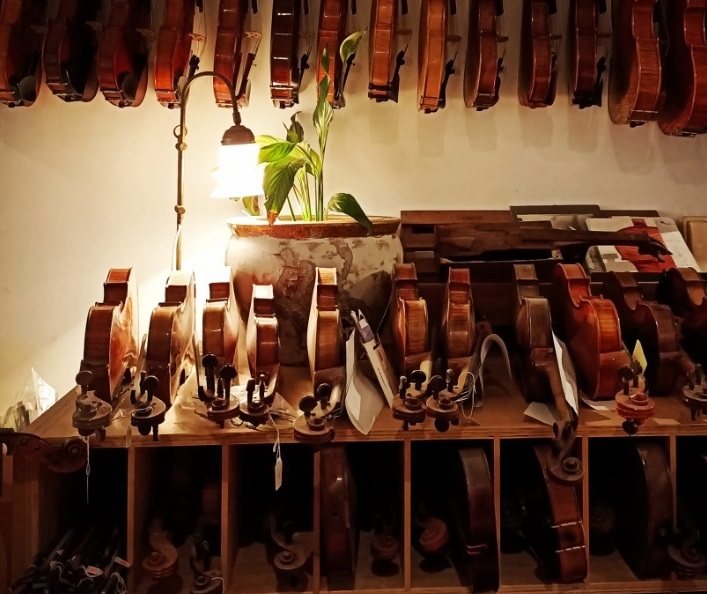The Violin Chronicles Podcast
In this podcast I will be telling the wild and wonderful stories englobing the lives of famous violin makers, what they got up to and placing them in their historical and musical context. We will look at instrument makers such as Gasparo da Salo, the Amati family, Guarneri Del Gesu and Stradivari just to name a few. Who were these people? What were their lives like? What was Stradivaris secret? and most importantly why and how did they make these master pieces we see and revere today. What was the first ballet like that Andrea Amati’s instruments played in, costing millions? Why did Antonio Stradivari have a shotgun wedding? and did Guarneri del Gesu really go to prison for murder? I speak to historians, musicians, violin makers and experts to unveil the stories of these beautiful violins, violas, cellos, double basses and the people who made them.
Episodes

Monday Mar 31, 2025
Cremona Violins and Varnish by Charles Reade
Monday Mar 31, 2025
Monday Mar 31, 2025
Charles Reade the dramatist and violin dealer wrote 4 letters to the Pall Mall Gazette in 1872 about Cremona violins, google says "This work has been selected by scholars as being culturally important, and is part of the knowledge base of civilization as we know it!" So listen on! I say.
To understand what these letters are about here is an intro with Benjamin Hebbert.

Tuesday Mar 25, 2025
Pietro Guarneri of Mantua express version
Tuesday Mar 25, 2025
Tuesday Mar 25, 2025
This is the life and times of Pietro Guarneri of Mantua. Join me as I explore this lesser-known Guarneri his truly beautiful instruments and his unique working conditions. This is a condensed version of the previous series on Pietro of Mantua if you would like the more elaborate tale I invite you to listen to episodes 29-31.

Thursday Feb 20, 2025
Ep 36. Guiseppe Guarneri Filius Andrea Part 5
Thursday Feb 20, 2025
Thursday Feb 20, 2025
In this final episode on the life of Giuseppe Guarneri Filius Andrea. Join me as I delve into end of the tumultuous life of this maker who turns out to be much more important than I could have ever imagined to the Life, style, workmanship and just plain understanding of his son Guarneri Del Gesu and his violins.

Wednesday Feb 12, 2025
Ep 35. Giuseppe Guarneri Filius Andrea Part 4
Wednesday Feb 12, 2025
Wednesday Feb 12, 2025
Hello and welcome to the violin Chronicles this is the 4th episode on the life of Filius Andrea and we will see how and why his youngest son Giuseppe or Guarneri Del Gesu as we more commonly know him as will step up to start helping his father and I will also be talking to the expert Christopher Reuning about identifying the hand of both Del Gesu and Pietro of Venice in the works labelled Giuseppe Guarneri filius Andrea. To listen to this full episode join us over at Patreon and sign up to have access to this and many more episodes.

Wednesday Feb 05, 2025
Ep 34. Giuseppe Guarneri Filius Andrea Part 3
Wednesday Feb 05, 2025
Wednesday Feb 05, 2025
Welcome to the violin Chronicles, in this episode we are going to explore Giuseppe’s challenges following the death of his parents, holding up against the giant working next door Antonio Stradivari, and the impact of the War of the Spanish Succession on Guarneris business and family. The city of Cremona becomes a battleground as French and Austrian troops vie for control, culminating in the Battle of Cremona in 1702. And Despite these difficulties, Giuseppe continues to craft instruments, experimenting with new models we will live through Cremona’s ups and downs, repeated flooding, and Guiseppes personal tragedies, including the loss of one of his children which will change the outlook of the Guarneri workshop form now on and lets see how he gets on with his remaining children. This is a Patreon only ep which means if you would like To listen come and join us on Patreon.com/theviolinchronicles where you will be able to listen to this show and a whole lot more exclusive patreon only content. When you are there why not listen to the episode on Shakespeare and the soundpost and the next time you are watching Romeo and Juliette you can pipe up with some violin trivia.

Tuesday Jan 28, 2025
Ep. 33 Giuseppe Guarneri Filius Andrea Part 2
Tuesday Jan 28, 2025
Tuesday Jan 28, 2025
Hello! In this second episode we will continue to delve into the life of violin maker Giuseppe Filius Andrea Guarneri. And I am Joined by Dr. Alan Maddox from the Sydney Conservatorium of Music, as we explore the musical landscape of the late 17th century, focusing on the trio sonata and its impact on violin making (because yes it does have an impact!). Come and join me as I take a look at Giuseppe's life, his growing family, and his inheritance complications after the death of his father, Andrea Guarneri. Discover with me why the development of printed music influenced so many musicians at the time of Giuseppe Guarneri Filius Andrea, and we take a sneak peak at the lifestyles of virtuoso performers, and the intricate connections between different musical styles in different parts of Europe at this time because it will ultimately help us to understand these violin makers so much more. And finally we unveil how these historical musicians and their innovations continue to affect our understanding of music and instrument making today. Now if you would like to join me for these episodes on Giuseppe Guarneri Filius Andrea pleas go to Patreon.com/thevioinchronicles where you will have access to these exclusive episodes and a whole bunch more, I hope to see you there.

Wednesday Jan 22, 2025
Ep 32. Giuseppe Guarneri or Filius Andrea Part 1
Wednesday Jan 22, 2025
Wednesday Jan 22, 2025
In this episode of 'The Violin Chronicles,' Linda Lespets takes listeners through the life of Giuseppe Guarneri, also known as Filius Andrea, a seminal violin maker from Cremona in the 17th century. The discussion begins with the significance of understanding Giuseppe to fully appreciate his more famous son, Guarneri del Gesù. Giuseppe's We look at his early life, his family dynamics, and the socio-economic environment of Cremona, while spotlighting the intricacies of his violin-making career. Through the lens of historical events and familial relationships, listeners learn about Giuseppe's craftsmanship, his rivalry with contemporary luthiers like Stradivari, and his contributions to cello design. This episode provides a comprehensive look at how his work and legacy intertwined with that of his distinguished family. Join Linda on Patreon.com/theviolinchronicles for exclusive content and insights into the lives of other great violin makers.

Monday Nov 11, 2024
Ep 31. Pietro Guarneri of Mantua part 4 When your boss is a class A loser.
Monday Nov 11, 2024
Monday Nov 11, 2024
Here we are! The final chapter in the life of Pietro Guarneri of Mantua, a distinguished violin maker, and his experiences during a turbulent period in history. Pietro's mother-in-law joins their household in 1700. Pietro's style of violin making has evolved substantially, reflecting the broader and bolder designs of his instruments.
However, family tensions arise as his brother Giuseppe fails to pay Pietro his share of their father's inheritance, eventually resolving the dispute after several years. Meanwhile, historical events significantly impact Pietro’s life. The death of the King of Spain in 1700 sparks the War of Spanish Succession, embroiling Mantua in conflict as the French and Austrians vie for control over northern Italian territories.
This period sees devastating consequences for Pietro's family, including the death of his daughter Eleonora and the chronic instability caused by shifting political powers. Despite these challenges, Pietro continues his craft, even as the Austrians eventually claim Mantua what will happen to our violin maker Pietro Guarneri?
Personal tragedies persist with the death of more children, but Pietro forges on, making exquisite instruments until his death in 1720.
Mantua is transforming how will the art of the violin makers survive this upheaval?

Monday Nov 04, 2024
Ep 30. Pietro of Mantua Part 3 He had HOW many children you say?
Monday Nov 04, 2024
Monday Nov 04, 2024
Welcome back to the complex and eventful life of Pietro Guarneri of Mantua. This episode explores Pietro's struggle of managing six children alone, the influence of Jacob Steiner on his instruments, and the familial conflicts over inheritance. We look at Pietro's work for the court of Mantua, including his decorated instruments with the fleur de lis patterns, why did he do this? Find out all! The episode also touches on the personal hardships Pietro faced, such as the death of his wife Caterina and subsequent remarriage to Lucia Birani. Financial challenges, especially related to dowries and house payments, are prominent, alongside Pietro's continuous dedication to his craft and the musical court despite political instability. Andrea Guarneri's death left a few curved balls for his sons to sort out, let see how the brothers (Pietro of Mantua and Giuseppe Filius Andrea) manage.

Monday Oct 28, 2024
Ep 29. Pietro of Mantua Part 2 And the court of intrigue!
Monday Oct 28, 2024
Monday Oct 28, 2024
In this episode of The Violin Chronicles, the life of Pietro Guarneri, Andrea Guarneri's eldest son, continues as he and his wife Caterina move to Mantua, a culturally rich yet politically tumultuous city. This episode opens a window onto Pietro's daily life, his tasks for the imprudent Duke Ferdinando Carlo, and the socio-political environment of 17th-century Mantua. This episode also explores the impact of European power struggles, particularly the War of the Spanish Succession, on the Guarneri family and Mantuan society. Pietro's craftsmanship, family dynamics, and interactions with the declining ducal court stand at the forefront, offering a rich historical tapestry in which our violin maker despite tough times was making a go of it.

Support The Violin Chronicles
A podcast about the well known and the not so well known violinmakers of history.
If you would like to support the Podcast that would be wonderful and mean a great deal to us! Please copy and paste this link to do so. https://patreon.com/TheViolinChronicles







